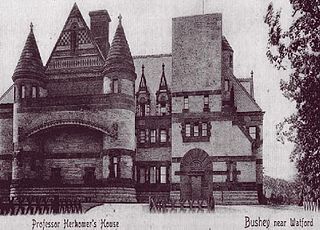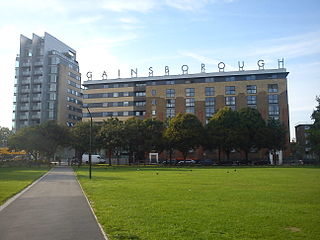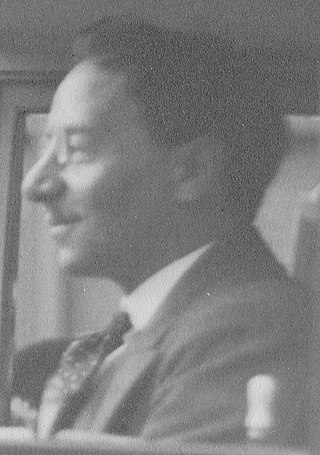
Bushey is a town in the Hertsmere borough of Hertfordshire in the East of England. It had a population of 25,328 in the 2011 census, rising to 28,416 in the 2021 census, an increase of 12.19%. This makes Bushey the second most populated town in Hertsmere. Bushey Heath is a large neighbourhood south east of Bushey on the boundary with the London Borough of Harrow reaching elevations of 165 metres (541 ft) above sea level.

Denham Film Studios was a British film production studio operating from 1936 to 1952, founded by Alexander Korda, in Buckinghamshire.

Lewisham West was a borough constituency in south-east London represented in the House of Commons of the Parliament of the United Kingdom. It elected one Member of Parliament (MP) by the first past the post system of election from 1918, until it was abolished for the 2010 general election.

Catford Stadium was a historic greyhound racing stadium in Catford, a suburb of London.

The Mount was a football stadium in Catford, located in the south west corner of what later became Mountsfield Park. Football was played there as early as the mid 19th century. Catford Southend F.C. used this as their home ground and eventually developed the land into a proper stadium with terracing, and it also hosted Charlton Athletic games in the 1923–1924 season. Unusually, the stadium was elevated above its surroundings, which may have given rise to its name.
Isleworth Studios is the common name of two former film studios in Great Britain.

Lululaund was the Romanesque Revival-style house and studio of the Bavarian-born British artist Hubert von Herkomer, in Melbourne Road, Bushey, Hertfordshire. It was designed about 1886 and completed by 1894. The house was demolished in 1939.

The BBC Elstree Centre, sometimes referred to as the BBC Elstree Studios, is a television production facility, currently owned by the BBC. The complex is located between Eldon Avenue and Clarendon Road in Borehamwood, Hertfordshire, England.
The bombing of Sandhurst Road School occurred during an air raid on Wednesday, 20 January 1943 when the school on Ardgowan Road, Catford, south east London was seriously damaged. A German fighter-bomber dropped a single 500-kilogram (1,100 lb) bomb on the school at 12:30 pm, killing 38 children and 6 staff and injuring another 60 people. Many were buried for hours under the rubble.
Walter Alabaster West was an English film director and producer. He was a partner in the film production company Broadwest Films.
The Merchant of Venice is a 1916 British silent drama film directed by Walter West and starring Matheson Lang, Hutin Britton, Ernest Caselli. It is an adaptation of William Shakespeare's play The Merchant of Venice.

Islington Studios, often known as Gainsborough Studios, were a British film studio located on the south bank of the Regent's Canal, in Poole Street, Hoxton in the former Metropolitan Borough of Shoreditch, London between 1919 and 1949. The studios are closely associated with Gainsborough Pictures which was based there for most of the studio's history. During its existence Islington worked closely with its sister Lime Grove Studios in Shepherd's Bush and many films were made partly at one studio and partly at the other. Amongst the films made at the studios were Alfred Hitchcock thrillers, Will Hay comedies and Gainsborough Melodramas.
Bushey Studios was a British film studio located in Melbourne Road, Bushey, Hertfordshire which operated between 1913 and 1985. The studios were built by the film enthusiast Hubert von Herkomer in the grounds of his country house, Lululaund. They gradually took on a more professional air and in 1915 they were acquired by the British Actors Film Company for use as their principal production base. After the company ran into problems, the studio was closed during much of the 1920s. During the 1930s film boom, it was re-opened and used to produce a number of quota quickies.
Walthamstow Studios was a British film studio located in Walthamstow, London which operated between 1914 and 1930. Two earlier studios had previously existed in Walthamstow. It was the base of Broadwest films for a number of years, which also used Catford Studios as an overflow facility. It was later owned by British Filmcraft. After the bankruptcy the studios were sold off for non-film use.
Cricklewood Studios, also known as the Stoll Film Studios, were British film studios located in Cricklewood, London which operated from 1920 to 1938. Run by Sir Oswald Stoll as the principal base for his newly formed Stoll Pictures, which also operated Surbiton Studios, the studio was the largest in the British Isles at that time. It was later used for the production of "quota quickies". In 1938, the studios were sold off for non-film use.
The Kew Bridge Studios were a British film studio located in Kew Bridge, Brentford, west London which operated from 1919 to 1924. The site had originally been a theatre, but due to the rapid expansion of the British film industry after the First World War it switched to filmmaking as the existing studios were overspilling. The studios hosted a number of independent film-makers during the silent era, including Walter West and Guy Newall.
The Man Who Bought London is a 1916 British silent crime film directed by Floyd Martin Thornton and starring E.J. Arundel, Evelyn Boucher and Roy Travers. It was based on the 1915 novel The Man Who Bought London by Edgar Wallace. It was the first of many Wallace stories to be adapted into films. It was made at Catford Studios.

Ludwig Blattner was a German-born inventor, film producer, director and studio owner in the United Kingdom, and developer of one of the earliest magnetic sound recording devices.
Broadwest or the Broadwest Film Company was a British film production company of the silent era. Its name it a portmanteau of its two founders, George Broadbridge and the film director Walter West. West took an active role in the company's productions, directing and producing many of the films. The company gained a reputation for producing films about horse racing, often based on popular novels such as those of Nathaniel Gould.
Frank Wilson (1873–?), was a British actor, writer and film director. Wilson was a prolific director during the silent era, shooting well over 200 shorts and feature films. He worked at the pioneering Hepworth Pictures in Walton Studios and later at Broadwest of Walthamstow Studios.








